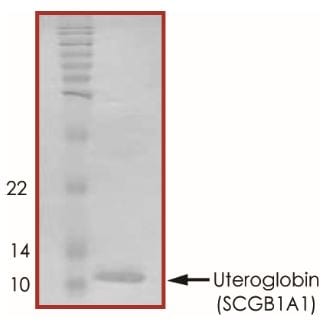Recombinant human Uteroglobin protein (ab269129)
Key features and details
- Expression system: Escherichia coli
- Endotoxin level:
- Active: Yes
- Suitable for: SDS-PAGE
-
Product name
Recombinant human Uteroglobin protein
See all Uteroglobin proteins and peptides -
Purity
95 % SDS-PAGE. -
Endotoxin level
Expression system
Escherichia coliAccession
Protein length
Full length proteinAnimal free
NoNature
Recombinant-
Species
Human -
Sequence
EICPSFQRVI ETLLMDTPSS YEAAMELFSP DQDMREAGAQ LKKLVDTLPQ KPRESIIKLM EKIAQSSLCN -
Molecular weight information
Approx 8.2 kDa by SDS-PAGE -
Amino acids
22 to 91 -
Additional sequence information
Full-length chain lacking the signal peptide
Specifications
Our Abpromise guarantee covers the use of ab269129 in the following tested applications.
The application notes include recommended starting dilutions; optimal dilutions/concentrations should be determined by the end user.
-
Applications
SDS-PAGE
-
Form
Lyophilized -
 Concentration information loading...
Concentration information loading...
Preparation and Storage
-
Stability and Storage
Shipped at 4°C. Store at -20°C or -80°C. Avoid freeze / thaw cycle.
Constituent: 100% PBS
0.2 µm filtered.This product is an active protein and may elicit a biological response in vivo, handle with caution.
-
ReconstitutionA quick spin of the vial followed by reconstitution in sterile PBS to a concentration not less than 0.1 mg/mL. Reconstituted protein can be stored in working aliquots at 4oC for 1 month or at -20oC for 6 months in the presence of a carrier protein.
General Info
-
Alternative names
- CC10
- CCPBP
- Clara cell 17 kDa protein
see all -
Relevance
Human Clara Cell Protein belongs to the family of secretoglobins and is a secreted protein product of nonciliated bronchiolar Clara cells. There is convincing data suggesting that it has phospholipase A2 inhibitory activity, as well as, a number of other immunomodulatory features including inhibition of interferon gamma signalling and Th1 vs. Th2 lymphocyte regulation. It was proposed as a potential peripheral marker of respiratory epithelial injury and bronchial dysfunction. Clara Cell Protein 16 concentrations have been determined in both serum and bronchoalveolar lavage fluid in numerous studies since 1994. In serum, its increase is associated with age, asbestos, nitrogen chloride and ozone exposure, sarcoidosis and high PEEP ventilation. Decreased serum CC16 levels are found after pulmonary resection, in silica-exposed workers, smokers and in asthma. Decreased CC16 concentrations were also found in the amniotic fluid of fetuses suffering from pulmonary hypoplasia caused by various mechanisms (diaphragmatic hernia, diabetic fetopathy, Turner and Down syndrome).
Images
Protocols
To our knowledge, customised protocols are not required for this product. Please try the standard protocols listed below and let us know how you get on.
Datasheets and documents
References (0)
ab269129 has not yet been referenced specifically in any publications.
Preparation and Storage
- CC10
- CCPBP
- Clara cell 17 kDa protein







